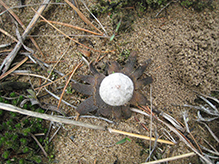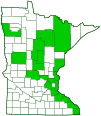Barometer Earthstars
(Astraeus spp.)
Overview • Description • Distribution • Taxonomy
Astraeus species look like earthstars in the genus Geastrum but they are not closely related. Astraeus species are in the order Boletales. They get their nutrients from the living rootlets of trees and shrubs. They are found in forests, woodlands, and open areas, always near trees or shrubs. Geastrum species are in the order Geastrales. They get their nutrients from decaying organic material (saprobic). They are found in deserts and other arid and semi-arid habitats. |
||
Description |
||
The fruiting body is a thick layer of flesh surrounding a round spore sac. As it matures, the outer layer splits into rays. The rays are hygroscopic. When moist, they are open and bent backward beyond the horizontal, elevating the spore sac above the ground. When dry, they close up and surround the spore sac. |
||
Distribution |
||||
|
Sources |
|||
| 10/17/2023 | ||||
Taxonomy |
|||
| Kingdom | Fungi (Fungi) | ||
| Subkingdom | Dikarya | ||
| Phylum | Basidiomycota (Basidiomycete Fungi) | ||
| Subphylum | Agaricomycotina (Higher Basidiomycetes) | ||
| Class | Agaricomycetes (Mushrooms, Bracket Fungi, Puffballs, and Allies) | ||
| Subclass | Agaricomycetidae | ||
| Order | Boletales (boletes and allies) | ||
| Suborder | Sclerodermatineae | ||
| Family | Diplocystidiaceae | ||
Genus |
Astraeus (barometer earthstars) | ||
Family Species Molecular and phylogenetic studies since 2003 have identified several new species that were previously classified as A. hygrometricus. The most recent of these studies (Phosri et al., 2013) showed that the type species, A. hygrometricus, occurs only in southern France and Turkey. In the United States, western specimens were grouped under A. pteridis. Two new species were described, A. morganii in southern U.S. and Mexico, and A. smithii in central and northern U.S. According to Michael Kuo (MushroomExpert.com), the 2013 paper “…is riddled with errors, inconsistent species descriptions, and poor documentation; I believe further research is required before accepting the paper's suggestions.” |
|||
Subordinate Taxa |
|||
barometer earthstar (Astraeus asiaticus) barometer earthstar (Astraeus koreanus) barometer earthstar (Astraeus morganii) barometer earthstar (Astraeus odoratus) barometer earthstar (Astraeus pteridis) barometer earthstar (Astraeus sirindhorniae) barometer earthstar (Astraeus telleriae) Hygroscopic Earthstar (Astraeus hygrometricus) |
|||
Synonyms |
|||
|
|||
Common Names |
|||
Barometer Earthstars |
|||
Glossary
Mycorrhizal
A symbiotic, usually beneficial relationship between a fungus and the tiny rootlets of a plant, usually a tree.
Saprobic
A term often used for saprotrophic fungi. Referring to fungi that obtain their nutrients from decayed organic matter.
Visitor Photos |
|||||
Share your photo of this fungus. |
|||||
| This button not working for you? Simply email us at info@MinnesotaSeasons.com. Attach one or more photos and, if you like, a caption. |
|||||
Crystal Boyd |
|||||
 |
|||||
MinnesotaSeasons.com Photos |
|||||
|
|||||

Slideshows |
||

Visitor Videos |
|||
Share your video of this fungus. |
|||
| This button not working for you? Simply email us at info@MinnesotaSeasons.com. Attach a video, a YouTube link, or a cloud storage link. |
|||
Other Videos |
|||

Created: 10/17/2023
Last Updated:


